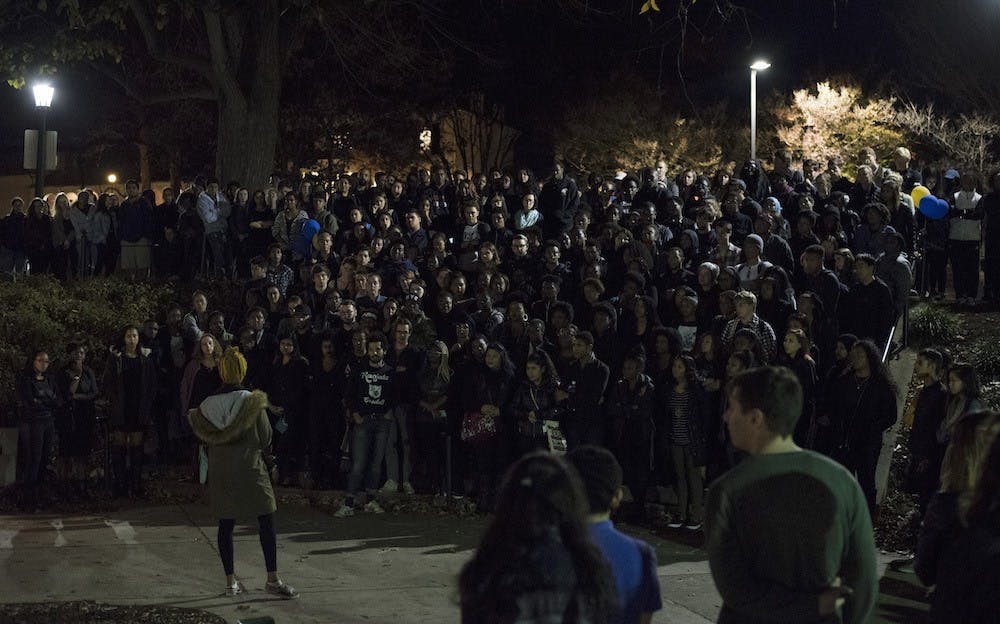The Black Student Alliance and the University Chapter of the NAACP held a gathering Thursday night at the Garrett Hall bus stop to demonstrate solidarity with student activists at Yale, the University of Missouri and Howard University.
The event, with more than 100 in attendance, opened with speakers from the NAACP and the BSA, as well as the performance of a song and the recitation of the poem, “If We Must Die” by Claude McKay. Event organizers then opened up the floor to all students to share their thoughts and experiences.
Fourth-year College student Jenné Nurse, president of the University Chapter of the NAACP and one of the opening speakers at the demonstration, said the racially motivated incidents that have occurred at Yale and the University of Missouri are not isolated incidents.
“There have been incidents that have occurred here at the University,” Nurse said. “We’ve all experienced our own racially motivated incidents here — I know I have personally every year since I began school here.”
White privilege exists even in situations where people may not realize it is prevalent, Nurse said.
“There are people who benefit from those structures whether or not they know it, or believe in it, or agree with it, they still benefit from it and that’s what I like to call white privilege,” she said.
Nurse said a large reason why she thinks people ignore institutionalized racism is because they do not want to take the time to realize the wrongs that have been done and how those wrongs still play a role now.
“Oftentimes I find that individuals say things like, ‘Well I didn’t do anything, so why are we still talking about this?’” Nurse said. “It’s not about what you may or may not be doing, it’s about structures that are in place.”
The BSA and NAACP chapter also promoted a “Blackout for Mizzou” on Thursday, encouraging students to dress in black, as a demonstration of togetherness, support and solidarity.
Magdalene Kwakye, a second-year College student and the director of programming for the BSA, said she was in attendance in support of race relations.
“It’s not about black people, or hispanics, or whites, but humans and how humans should be treated,” Kwakye said. “It’s as simple as that.
Haden Parrish, a second-year College student, was in attendance as an ally for the cause.
“This is a fight for a black issue, but as a white person, as an ally, it is our duty to support that fight,” he said. “There was a great turnout, but it needs to be bigger. We need to be able to fill up our amphitheater, there needs to be sports teams present.”
It is important to know that there are people standing with you on these issues, Nurse said, and that injustices must be confronted in the face of opposition.
“It’s courageous and it’s brave to speak out on injustices and it’s hard because you get a lot of pushback,” Nurse said. “Sometimes from administrators, sometimes from your family because they want you to be safe, sometimes from your friends because they may not understand.
The University can learn from the events at Mizzou, Michael Mason, assistant dean of the Office of African American Affairs, said.
“We hold the University of Missouri community in our minds as they brace themselves for the long and hard work of standing together to reunite their community after a tumultuous several months preceded by decades of hostility along racial lines,” Mason said in an email statement. “We are sure there will be much to learn from that community.”
One thing that the University community should take out of this is how much can be accomplished when communities come together, he said.
“Thus far, it is clear, however, that a community standing together for change is powerful,” he said. “Faculty, staff, students and community members uniting for a cause is a beautiful thing. We will continue to watch for examples of communities galvanizing in and outside of crisis to ensure that the experience of learning for all of its members is growth promoting rather than harmful.”
The text of the BSA's statement of support for University of Missouri and Yale students, circulated on Nov. 11, can be found below.






